Life
Remistus was a Visigoth, as shown by his Germanic name. In 456 Remistus reached a high military rank under Emperor Avitus, who probably appointed him magister militum , and received the rank of patricius : he was the first magister militum since the death of Aetius in 454 and the first barbarian magister militum.
The newly appointed general took up residence in Ravenna, the capital, with a group of Goths. That same year Avitus, who was opposed by the Roman Senate, decided to leave Italy and go to his native Gaul to gather reinforcements; Remistus remained back to control Italy. He clashed with the Senate army, led by the Italian magister militum Ricimer and was forced to return to Ravenna; besieged, he was captured and put to death in the Palace in Classis, just outside the city, on September 17.
The following month, Avitus was deposed and later died.
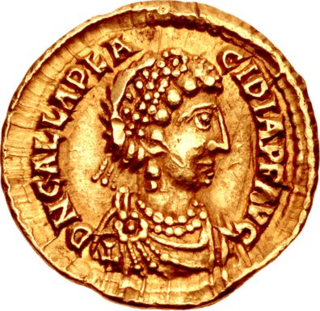
Galla Placidia, daughter of the Roman emperor Theodosius I, was a mother, tutor, and advisor to emperor Valentinian III. She was queen consort to Ataulf, king of the Visigoths from 414 until his death in 415, briefly empress consort to Constantius III in 421, and managed the government administration as a regent during the early reign of Valentinian III until her death.
The 450s decade ran from January 1, 450, to December 31, 459.

Year 455 (CDLV) was a common year starting on Saturday of the Julian calendar. At the time, it was known as the Year of the Consulship of Valentinianus and Anthemius. The denomination 455 for this year has been used since the early medieval period, when the Anno Domini calendar era became the prevalent method in Europe for naming years.

Year 456 (CDLVI) was a leap year starting on Sunday of the Julian calendar. At the time, it was known as the Year of the Consulship of Avitus without colleague. The denomination 456 for this year has been used since the early medieval period, when the Anno Domini calendar era became the prevalent method in Europe for naming years.

Julius Nepos, or simply Nepos, ruled as Roman emperor of the West from 24 June 474 to 28 August 475. After losing power in Italy, Nepos retreated to his home province of Dalmatia, from which he continued to claim the western imperial title, with recognition from the Eastern Roman Empire, until he was murdered in 480. Though Nepos' successor in Italy, Romulus Augustulus, is traditionally deemed the last western Roman emperor, Nepos is regarded by some historians as the true last emperor of the west, being the last widely recognised claimant to the position.

Ricimer was a Romanized Germanic general who effectively ruled the remaining territory of the Western Roman Empire from 456 after defeating Avitus, until his death in 472, with a brief interlude in which he contested power with Anthemius. Deriving his power from his position as magister militum of the Western Empire, Ricimer exercised political control through a series of puppet emperors. Ricimer's death led to unrest across Italy and the establishment of a Germanic kingdom on the Italian Peninsula.
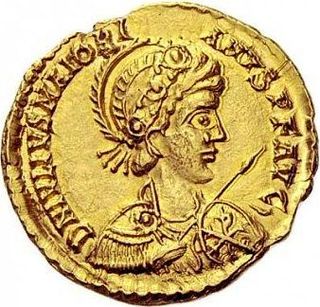
Majorian was the Western Roman emperor from 457 to 461. A prominent commander in the Western military, Majorian deposed Avitus in 457 with the aid of his ally Ricimer. Possessing little more than Italy, Dalmatia, as well as some territory in Hispania and northern Gaul, Majorian campaigned rigorously for three years against the Empire's enemies. In 461, he was murdered at Dertona in a conspiracy, and his successors until the Fall of the Empire in 476 were puppets either of barbarian generals or the Eastern Roman court.

Zeno was Eastern Roman emperor from 474 to 475 and again from 476 to 491. He was originally from the district of Isauria, which is now part of modern day Turkey, and changed his name to Zeno while serving under Leo I.

Procopius Anthemius was the Western Roman emperor from 467 to 472. Born in the Eastern Roman Empire, Anthemius quickly worked his way up the ranks. He married into the Theodosian dynasty through Marcia Euphemia, daughter of Eastern emperor Marcian. He soon received a significant number of promotions to various posts, and was presumed to be Marcian's planned successor. However, Marcian's sudden death in 457, together with that of Western emperor Avitus, left the imperial succession in the hands of Aspar, who instead appointed Leo, a low-ranking officer, to the Eastern throne, probably out of fear that Anthemius would be too independent. Eventually, this same Leo designated Anthemius as Western emperor in 467, following a two-year interregnum that started in November 465.

Constantius III was briefly Western Roman emperor in 421, having earned the throne through his capability as a general under Honorius. By 411 he had achieved the rank of magister militum, and in the same year he suppressed the revolt of the usurper Constantine III. Constantius went on to lead campaigns against various barbarian groups in Hispania and Gaul, recovering much of both for the Western Roman Empire. He married Honorius's sister Galla Placidia in 417, a sign of his ascendant status, and was proclaimed co-emperor by Honorius on 8 February 421. Constantius reigned for seven months before dying on 2 September 421.
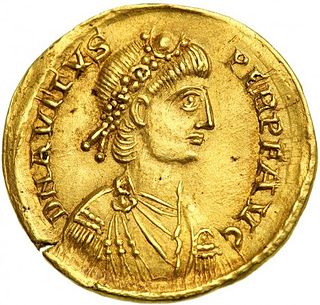
Eparchius Avitus was Roman emperor of the Western Empire from July 455 to October 456. He was a senator of Gallic extraction and a high-ranking officer both in the civil and military administration, as well as Bishop of Piacenza.
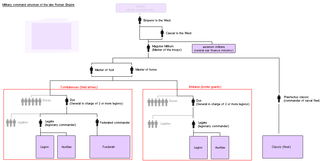
Magister militum was a top-level military command used in the later Roman Empire, dating from the reign of Constantine the Great. The term referred to the senior military officer of the empire. In Greek sources, the term is translated either as strategos or as stratelates.

Petronius Maximus was Roman emperor of the West for two and a half months in 455. A wealthy senator and a prominent aristocrat, he was instrumental in the murders of the Western Roman magister militum, Aëtius, and the Western Roman emperor, Valentinian III.

The term Western Roman Empire is used in modern historiography to refer to the western provinces of the Roman Empire, collectively, during any period in which they were administered separately from the eastern provinces by a separate, independent imperial court. Particularly during the period from AD 395 to 476, there were separate, coequal courts dividing the governance of the empire into the Western provinces and the Eastern provinces with a distinct imperial succession in the separate courts. The terms Western Roman Empire and Eastern Roman Empire were coined in modern times to describe political entities that were de facto independent; contemporary Romans did not consider the Empire to have been split into two empires but viewed it as a single polity governed by two imperial courts for administrative expediency. The Western Empire collapsed in 476, and the Western imperial court in Ravenna disappeared by AD 554, at the end of Justinian's Gothic War.

Marcellinus was a Roman general and patrician who ruled over the region of Dalmatia in the Western Roman Empire and held sway with the army there from 454 until his death. Governing Dalmatia both independently from, and under, six Emperors during the twilight of the Western Empire, Marcellinus proved to be an able administrator and military personality with sources making reference that he ruled justly and well and kept Dalmatia independent of the emperor and of barbarian rulers.
Ecdicius Avitus was an Arverni aristocrat, senator, and magister militum praesentalis from 474 until 475.
Agrippinus was a general of the Western Roman Empire, Magister militum per Gallias under emperors Valentinian III, Petronius Maximus, Avitus and Libius Severus.
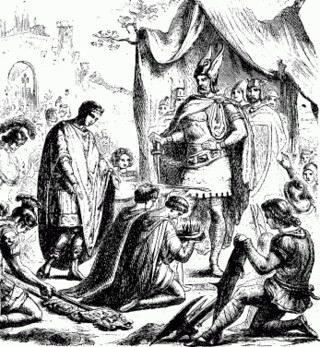
Odoacer's deposition of Romulus Augustus, occurring in 476 AD, was a coup that marked the end of the reign of the Western Roman Emperor last approved by the Western Roman Senate and the creation of the Kingdom of Italy, although Julius Nepos exercised control over Dalmatia until 480.

The Gothic War of 457-458 was a military conflict between the Visigoths of Theoderic II against the Western Roman Empire of Emperor Majorian. The war began in 457 with a revolt of the Goths in Aquitania that pushed aside Roman authority, followed by an aggressive conquest in the adjacent Septimania aimed at area expansion. The war ended with a Roman victory over the Goths in the Battle of Arles in 458.

The Roman Civil War of 456 was a military conflict in the 2nd half of 456 in which the generals Majorianus and Ricimer revolted against the West Roman Emperor Avitus. The war ended with a victory by the insurgents. Avitus was deposed as emperor and died shortly thereafter in mysterious circumstances.
















